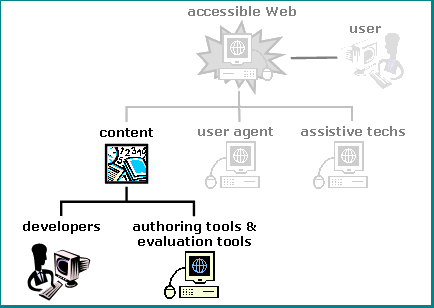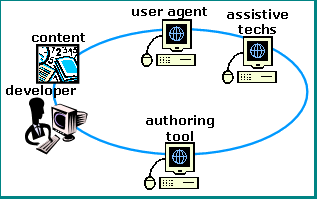

Components of Web Accessibility
Version: Early Concept Draft 2004.08.27
Note: This document is an unapproved draft and should not be
distributed, referenced, or quoted under any circumstances. This
document is under development by the Education and Outreach Working Group
(EOWG), and will be offered to other W3C groups and the public for review. A
change log lists revisions in
progress and links to previous versions.
Introduction
The purpose of this document is to briefly show how Web accessibility
depends on several components working together. It also shows how
improvements in specific components could substantially improve Web
accessibility.
How the Components Relate
Whether or not a Web site is accessible to a person using
the site ("user") is largely based on:
- content - the information on the Web site, including
text, images, forms, sounds, etc.
- Web browsers, media players, and other "user
agents"
- in some cases, assistive technology -screen readers,
alternative keyboards, switches, scanning software, etc.
- Users' knowledge, experiences, and in some cases,
adaptive strategies using the Web
The accessibility of the content is largely determined
by:
- developers' accessibility knowledge, skill, and effort
- including designers, coders, authors, etc., which also includes "users"
who contribute content and people with disabilities
- authoring tools - software that creates Web sites
- evaluation tools - Web accessibility evaluation tools,
HTML validators, CSS validators, etc.
Guidelines for Components
WAI guidelines work together to inform the different
components of Web accessibility:
The basic technologies of the Web are fundamental to Web accessibility:
- WCAG, UAAG, ATAG, and W3C technical specifications
(HTML, XML, CSS, SVG, SMIL, etc.) are developed in coordination with each
other
- Web browser, media player, assistive technology, authoring tool,
evaluation tool, and content developers all refer to relevant technical
specifications
Inter-dependencies Between Components
There are significant inter-dependencies between the components; that is,
each component relies on other components for effective accessibility.
[@@ image ? ]
[alt example not revised yet - as recorded in changelog] For example, for
alternative text on images:
- Technical specification defines ALT
(HTML IMG element has ALT attribute)
- WCAG, UAAG, and ATAG define how it is implemented for
accessibility
- Authoring tools allow, encourage, and
provide help on ALT
- Developers provide the equivalent ALT
text
- Evaluation tools help check for
appropriate ALT
- Web browsers, or other user agent,
provide human and machine interface to ALT
- Assistive technologies provides human
interface to ALT in various modalities
- Users know how to get the ALT from their
browser, or other user agent, and/or assistive technology as needed
When accessibility features are effectively implemented in one component,
the other components are more likely to implement them.
- When user agents (including Web browser, media player, assistive
technologies) support an accessibility feature, users are more likely to
demand it and developers are more likely to implement it in their
content.
- When an accessibility feature is implemented in most sites (content),
developers and users are more likely to demand that user agents support
it.
- When authoring tools make a feature easy to implement, developers are
more likely to implement it in their content.
- When developers want to implement an accessibility feature, they are
more likely to demand that their authoring tool make it easy to
implement.
However, if one component does not implement an accessibility feature,
there is little motivation for the other components to implement it when it
does not result in an accessible user experience.
[@@ image? ]
When one component is weak, sometimes other components can compensate;
however, compensation usually involves much more effort and "work arounds"
that are not good for accessibility overall. For example,
- developers can do more work to compensate for some lack of
accessibility support in authoring tools
- user agents [@@ tweaks that then break other implementations]
Related Pages
Introduction to Web Accessibility
provides additional information about Web Accessibility.
Document Information
Editor: Shawn Lawton Henry. This Web page is is under development by the
EOWG.
Last updated $Date: 2004/09/16 02:08:17 $ by $Author: shawn $



